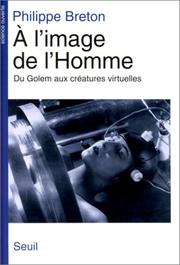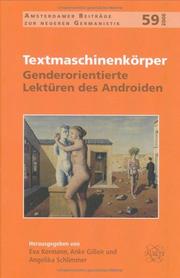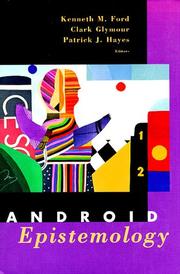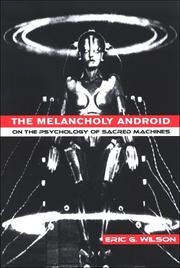| Listing 1 - 10 of 20 | << page >> |
Sort by
|
Book
ISBN: 9783846756577 9783770556571 3846756571 Year: 2014 Publisher: Paderborn : Wilhelm Fink Verlag,
Abstract | Keywords | Export | Availability | Bookmark
 Loading...
Loading...Choose an application
- Reference Manager
- EndNote
- RefWorks (Direct export to RefWorks)
Warum werden lebende Organismen, insbesondere der Mensch, als lebendige Maschinen verstanden? Warum hat der Mensch das Bedürfnis, sich selbst als Maschine nachzubauen? Das 18. Jahrhundert stand u.a. mit La Mettries Werk L’homme machine (1747) und den »lebendigen« Automaten eines Vaucansons im Zeichen verschiedener »Maschinentheorien des Lebendigen«. Um bis in die Gegenwart anhaltende Tradierungen und Wandlungen des damals fundierten Mensch-Maschinen-Konstrukts erfahrbar zu machen, rückt der Mensch als Forschungsobjekt der KI und der Robotik ins Blickfeld. Es steht zu beantworten, inwieweit die Rede vom Maschinenmenschen und der Bau künstlicher Maschinen dazu verhelfen, Wissen über den Menschen zu erlangen.
Robots. --- Androids. --- Artificial intelligence.
Multi
ISBN: 9780674982840 0674982843 9780674971738 0674971736 9780674982857 0674982851 Year: 2018 Publisher: Cambridge, MA : Harvard University Press,
Abstract | Keywords | Export | Availability | Bookmark
 Loading...
Loading...Choose an application
- Reference Manager
- EndNote
- RefWorks (Direct export to RefWorks)
Living with Robots recounts a foundational shift in the field of robotics, from artificial intelligence to artificial empathy, and foreshadows an inflection point in human evolution. Today's robots engage with human beings in socially meaningful ways, as therapists, trainers, mediators, caregivers, and companions. Social robotics is grounded in artificial intelligence, but the field's most probing questions explore the nature of the very real human emotions that social robots are designed to emulate. Social roboticists conduct their inquiries out of necessity--every robot they design incorporates and tests a number of hypotheses about human relationships. Paul Dumouchel and Luisa Damiano show that as roboticists become adept at programming artificial empathy into their creations, they are abandoning the conventional conception of human emotions as discrete, private, internal experiences. Rather, they are reconceiving emotions as a continuum between two actors who coordinate their affective behavior in real time. Rethinking the role of sociability in emotion has also led the field of social robotics to interrogate a number of human ethical assumptions, and to formulate a crucial political insight: there are simply no universal human characteristics for social robots to emulate. What we have instead is a plurality of actors, human and nonhuman, in noninterchangeable relationships. As Living with Robots shows, for social robots to be effective, they must be attentive to human uniqueness and exercise a degree of social autonomy. More than mere automatons, they must become social actors, capable of modifying the rules that govern their interplay with humans.--
Philosophy --- Robotics --- Androids --- Artificial intelligence. --- Social aspects.
Book
ISBN: 0128045825 0128045604 9780128045824 9780128045602 Year: 2019 Publisher: Oxford, United Kingdom : Butterworth-Heinemann, an imprint of Elsevier,
Abstract | Keywords | Export | Availability | Bookmark
 Loading...
Loading...Choose an application
- Reference Manager
- EndNote
- RefWorks (Direct export to RefWorks)
Androids. --- Robots. --- Automata --- Automatons --- Robotics --- Manipulators (Mechanism) --- Mecha (Vehicles) --- Humanoid robots --- Humanoids (Androids) --- Robots --- Virtual humans (Artificial intelligence)

ISBN: 2020134160 9782020134163 Year: 1995 Publisher: Paris: Seuil,
Abstract | Keywords | Export | Availability | Bookmark
 Loading...
Loading...Choose an application
- Reference Manager
- EndNote
- RefWorks (Direct export to RefWorks)
Les créatures artificielles peuplent une zone particulière de notre imaginaire, nourrie de vieilles légendes. Ce livre veut montrer qu'un lien existe entre toutes ces créatures, de la statue animée de Pygmalion au monstre de Frankenstein, en passant par les ordinateurs intelligents du XXe siècle. Les créatures artificielles tendent à l'homme un miroir où il est confronté à sa propre image.
Artificial life in art. --- Androids in art. --- Conscious automata in art. --- Arts.
Book
ISBN: 9027267642 9789027267641 9789027242693 9027242690 Year: 2016 Publisher: Amsterdam Philadelphia
Abstract | Keywords | Export | Availability | Bookmark
 Loading...
Loading...Choose an application
- Reference Manager
- EndNote
- RefWorks (Direct export to RefWorks)
Human-robot interaction. --- Gaze --- Robotics --- Androids. --- Humanoid robots --- Humanoids (Androids) --- Robots --- Virtual humans (Artificial intelligence) --- Automation --- Machine theory --- Body language --- Social perception --- HRI (Human-robot interaction) --- Robot-human interaction --- Human engineering --- Psychological aspects. --- Social aspects.

ISBN: 9042017783 1423787153 9781423787150 9789042017788 9789401201971 Year: 2006 Volume: 59 Publisher: Amsterdam New York, NY Rodopi
Abstract | Keywords | Export | Availability | Bookmark
 Loading...
Loading...Choose an application
- Reference Manager
- EndNote
- RefWorks (Direct export to RefWorks)
Textmaschinenko¨rper ist ein Neologismus, aufgebaut aus drei Lexemen, die, auf unterschiedliche Weise zu Neukombinationen verbunden - Textmaschine, Maschinenko¨rper, Textko¨rper -, jeweils das Sprachliche, Mechanische oder Leibliche betonen. Das Hyperonym der einzelnen Wo¨rter ist indes Konstruktion: Texte, Maschinen und Ko¨rper sind Artefakte, deren Herstellungsgeschichte und Wirkung zwar sehr unterschiedlich sein kann, aber deren Signum der menschlichen Konstruktion sie jeweils zu Elementen der Kulturpraxis im weitesten Sinn macht und deren Bedeutung immer wieder neu erfasst werden muss. Die unter dem Titel "Textmaschinenko¨rper" gesammelten Aufsa¨tze befassen sich mit der Darstellung des Maschinenko¨rpers in literarischen, filmischen und digitalen Texten. Sie analysieren Ko¨rper-, Geschlechter- und Menschenkonstruktionen, die auf einer Skala von Medien, vom schriftlich fixierten literarischen Text bis zur digitalen Vorstellung im Computerspiel, repra¨sentiert und thematisiert werden. Der Band pra¨sentiert erstmals dezidiert genderorientierte Analysen zum Motiv des ku¨nstlichen Menschen vor allem zur deutschsprachigen Literatur - von Automaten in der Dichtung des Mittelalters u¨ber Marionetten, Puppen und Automaten in der Romantik und in der Literatur des fin de sie`cle bis hin zu aktuellen Reflexionen u¨ber Ko¨rper, Technik und Reproduktion - und zur Variation des Motivs im Film des 20. Jahrhunderts - von Metropolis bis Matrix.
German literature --- Thematology --- Androids in literature --- Androiïden in de literatuur --- Androïdes dans la littérature --- Automata in literature --- Automaten in de literatuur --- Automates dans la littérature --- Humanoid robots in literature --- Humanoids in literature --- Robots dans la littérature --- Robots in de literatuur --- Robots in literature --- Androids in literature. --- Androids.

ISBN: 0262061848 Year: 1995 Publisher: Menlo Park (California) : AAAI press,
Abstract | Keywords | Export | Availability | Bookmark
 Loading...
Loading...Choose an application
- Reference Manager
- EndNote
- RefWorks (Direct export to RefWorks)
Androids --- Artificial intelligence --- Robotics --- Automation --- Machine theory --- AI (Artificial intelligence) --- Artificial thinking --- Electronic brains --- Intellectronics --- Intelligence, Artificial --- Intelligent machines --- Machine intelligence --- Thinking, Artificial --- Bionics --- Cognitive science --- Digital computer simulation --- Electronic data processing --- Logic machines --- Self-organizing systems --- Simulation methods --- Fifth generation computers --- Neural computers --- Humanoid robots --- Humanoids (Androids) --- Robots --- Androids. --- Artificial intelligence. --- Robotics. --- Virtual humans (Artificial intelligence)
Book
ISBN: 0739191462 9780739191460 9780739191453 0739191454 1498527582 Year: 2015 Publisher: Lanham
Abstract | Keywords | Export | Availability | Bookmark
 Loading...
Loading...Choose an application
- Reference Manager
- EndNote
- RefWorks (Direct export to RefWorks)
Imagining Slaves and Robots in Literature, Film, and Popular Culture: Reinventing Yesterday's Slave with Tomorrow's Robot is an interdisciplinary study that seeks to investigate and speculate about the relationship between technology and human nature through popular culture. Imagining Slaves and Robots in Literature, Film, and Popular Culture seeks to gain a better understanding of how slaves are created and justified in the imaginations of a supposedly civilized nation. It is a timely and creative analysis of the ways in which we domesticate technology and the manner in which the history of s
Technology --- Technology in popular culture. --- Slavery --- Slavery in art. --- Androids --- Androids in art. --- Humanoid robots --- Humanoids (Androids) --- Robots --- Virtual humans (Artificial intelligence) --- Abolition of slavery --- Antislavery --- Enslavement --- Mui tsai --- Ownership of slaves --- Servitude --- Slave keeping --- Slave system --- Slaveholding --- Thralldom --- Crimes against humanity --- Serfdom --- Slaveholders --- Slaves --- Popular culture --- Social aspects. --- Enslaved persons
Book
ISBN: 9783031441592 Year: 2024 Publisher: Cham Springer Nature Switzerland :Imprint: Springer
Abstract | Keywords | Export | Availability | Bookmark
 Loading...
Loading...Choose an application
- Reference Manager
- EndNote
- RefWorks (Direct export to RefWorks)
This SpringerBrief is a computational study of significant concerns and their role in forming long-term relationships between intelligent entities. Significant concerns include attitudes, preferences, affinities, and values that are held to be highly valued and meaningful: The means through which a person may find deeply held identity, purpose, and transformation. Significant concerns always engage the emotions and senses in a way that simply holding an opinion may or may not. For example, experiencing a significant concern may provoke deep feelings of awe and wonder in a way that deciding what to have for lunch probably does not, even if the lunch decision involves a rich array of preferences and values. Significant concerns also include what Emmons has called ultimate concerns. The author builds upon this base by considering the hypothetical case of intelligence in androids. An android is defined as a human-like robot that humans would accept as equal to humans in how theyperform and behave in society. An android as defined in this book is not considered to be imitating a human, nor is its purpose to deceive humans into believing that it is a human. Instead, the appropriately programmed android self-identifies as a non-human with its own integrity as a person. Therefore, a computational understanding of personhood and how persons – whether human or android – participate in relationships is essential to this perspective on artificial intelligence. Computational Modelling of Robot Personhood and Relationality describes in technical detail an implementation of a computational model called Affinity that takes the form of a simulation of a population of entities that form, maintain, and break relationships with each other depending upon a rich range of values, motivations, attitudes, and beliefs. Future experimentation and improvements of this model may be used not only to gain a wider understanding of human persons but may also form a preliminary cognitive model of the reasoning process of an android.

ISBN: 0791481328 1429405082 9781429405089 9780791468456 9780791481325 0791468453 0791468461 9780791468463 Year: 2006 Publisher: Albany State University of New York Press
Abstract | Keywords | Export | Availability | Bookmark
 Loading...
Loading...Choose an application
- Reference Manager
- EndNote
- RefWorks (Direct export to RefWorks)
The Melancholy Android is a psychological study of the impulses behind the creation of androids. Exploring three imaginative figures—the mummy, the golem, and the automaton—and their appearances in myth, religion, literature, and film, Eric G. Wilson tracks the development of android-building and examines the lure of artificial doubles untroubled by awareness of self. Drawing from the works of philosophers Ficino, Kleist, Freud, and Jung; writers Goethe, Coleridge, Shelley, and Poe; and movies such as Metropolis, The Mummy, and Blade Runner, this book not only offers a range of sites from which to analyze the relationship between mind and machine, but also considers a pressing paradoxical dilemma—loving machines we want to hate.
Androids. --- Melancholy. --- Mind and body. --- Body and mind --- Body and soul (Philosophy) --- Human body --- Mind --- Mind-body connection --- Mind-body relations --- Mind-cure --- Somatopsychics --- Brain --- Dualism --- Philosophical anthropology --- Holistic medicine --- Mental healing --- Parousia (Philosophy) --- Phrenology --- Psychophysiology --- Self --- Humanoid robots --- Humanoids (Androids) --- Robots --- Virtual humans (Artificial intelligence) --- Dejection --- Emotions --- Depression, Mental --- Sadness --- Psychological aspects
| Listing 1 - 10 of 20 | << page >> |
Sort by
|

 Search
Search Feedback
Feedback About UniCat
About UniCat  Help
Help News
News